![John Weber, All Power to the People, Cabrini-Green Public Housing Development, 357 W. Locust St, Chicago, 1969 [destroyed].jpg John Weber, All Power to the People, Cabrini-Green Public Housing Development, 357 W. Locust St, Chicago, 1969 [destroyed].jpg](https://486312.frmmmguz.asia/files/square_thumbnails/5bee9c55de2e128c0239ac4a0793b9c0.jpg)
All Power to the People
In 1969, in the courtyard of Saint Dominic’s Church in Cabrini-Green, John Pitman Weber painted All Power to the People with a team of black teenagers. The 37-foot-long mural put the antislavery leader Frederick Douglass alongside Malcolm X, Huey P. Newton and Erika Huggins on the right-hand-side. On the left are skeletons of police officers and a statement by the leader of the Chicago Black Panther Party, Fred Hampton: "Dare to Struggle, Dare to Win." A raised Black Power fist, enveloped by flames, holds broken chains in a symbol of self-emancipation. A few months after the creation of this mural, Fred Hampton was shot and killed by the FBI under J. Edgar Hoover’s COINTELPRO. Weber was a white Harvard graduate and Fulbright scholar. The mural was one of the first collaborations between untrained community residents and a trained artist, a method that became common practise for American community murals.
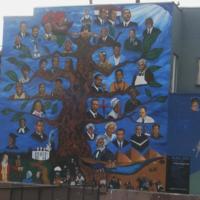
Black Seeds
In 1991, a group of artists – Eddie Orr, David Mosley, William T. Stubbs, Norman Maxwell and Michael McKenzie – collaborated to paint “Black Seeds” on an empty wall in Leslie N. Shaw Park on Jefferson and 3rd Avenue in Los Angeles. The idea for the mural, which appears as an African American tree of life, came from Vietnam veteran and local activist Gus Harris Jr. He recalled how little he learned about African American history in school. He wanted to create a public mural about black individuals who made an important contribution to society.The mural was created under the Social and Public Art Resource Center's 1990-91 “Neigborhood Pride: Great Walls Unlimited” mural program and features the antislavery leaders Harriet Tubman and Frederick Douglass, as well as Booker T. Washington, Thurgood Marshall, Mary McLeod Bethune, Malcolm X, George Washington Carver, Paul Robeson, Stevie Wonder, Shirley Chisholm, Martin Luther King Jr., and Jesse Jackson. The mural was restored by Moses X. Ball to include Barack Obama after 2008. The original canvas upon which the mural was based hangs in Oaks Jr. Market Corner Store at 5th and Jefferson.
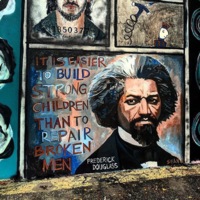
Strong Children
Painted by Charleston-based artist Sean Williams, this mural depicts the antislavery leader Frederick Douglass in the younger phase of his life, and uses his statement from in 1855, “It is easier to build strong children than to repair broken men.” The mural is in a church parking lot in Charleston, South Carolina.
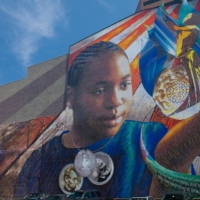
Lincoln Legacy
This large mural by Joshua Sarantitis, Lincoln Legacy, can be read from left to right, moving from Africa to America. The shape of Africa adorns the backdrop until the wooden boards of the slave ship transform into the American flag. Around the young child’s neck are three medallions: Abraham Lincoln’s face, Josiah Wedgwood’s abolitionist icon “Am I Not a Man and a Brother,” and Frederick Douglass' face. Made up of over 1 million glass mosaic tiles, it is the largest Venetian glass tile mural in Philadelphia at over 10,000 square feet. Located a block away from the Liberty Bell and Independence Mall, it is one of the few murals to be created in Philadelphia’s wealthier districts.
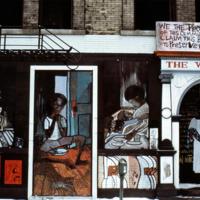
Wall of Truth
Although sharing an address with the famous Wall of Respect, the Wall of Truth was different. Whilst the Wall of Respect exalted black role models, leaders and liberators, the Wall of Truth wove negative scenes of poverty, brutality and racism into the fabric of the urban environment. Rather than promoting racial pride, it highlighted racial disparities. “The intent on the opposite side [of the road] was that things had gone more militant,” muralist Eugene Wade explained: “more blackness was needed in terms of representing the Black Power symbol and the whole thrust of what was happening in the black community.” Wade notes that “people were getting angry and fed up, so what we were trying to do was implement the attitude and the mood."The Wall of Truth was a significantly larger mural than its Chicago neighbour, the Wall of Respect. It spanned the length of an apartment building, and wrapped around onto an adjoining wall. It contained nine separate narrative panels and was one of the first instances that a radical black past was visualised in the streets through the antislavery leaders Frederick Douglass and Nathaniel Turner, as well as Mary McLeod Bethune, W.E.B. Du Bois, H. Rap Brown, Stokely Carmichael, Marcus Garvey, Huey P. Newton, Fred Hampton, and Malcolm X.
![Parkview Recreation Center Mural, Northwest at Otis Pl (Black Neighborhood), Washington DC, 1990s [destroyed 2010].jpg Parkview Recreation Center Mural, Northwest at Otis Pl (Black Neighborhood), Washington DC, 1990s [destroyed 2010].jpg](https://486312.frmmmguz.asia/files/square_thumbnails/2f5b42d937293f1b46430d226884e60b.jpg)
Parkview Recreation Center Mural
This mural was painted in the 1990s on the side of the Parkview Recreation Center in northwest Washington D.C. It depicts the faces of Thurgood Marshall, Mary McCleoud Bethune and the antislavery leader Frederick Douglass. In 2010 the mural was repainted and includes the same faces.
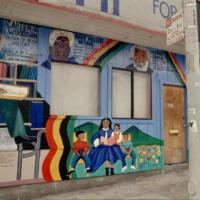
Scenes from the Bayview Opera House
Painted in 1995 in San Francisco by artist Leboriae P. Smoore, this mural acts as a children’s textbook in the street, teaching about the antislavery leaders Harriet Tubman and Frederick Douglass, and other black figures: Carter G. Woodson, Mary McLeod Bethune, W.E.B. Du Bois, Ida B. Wells, and Jackie Robinson.
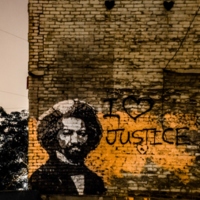
Frederick Douglass
The artist St George completed this stencil of a young Frederick Douglass in 2013. It had been destroyed by 2017.
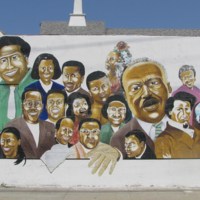
Wings of Faith
In 2005, an anonymous artist painted a mural in Los Angeles that depicted many heroes of African American history. The faces of antislavery leaders Sojourner Truth and Frederick Douglass, alongside Muhammad Ali, Martin Luther King Jr., Malcolm X and Rosa Parks, lined the street. By 2015, the building had fallen into disrepair and the mural had been destroyed.
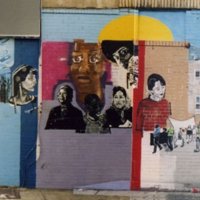
Women Warriors
In 2001, Brooklyn-based muralist Leola Bermanzohn created a mural in the Flatbush area of Brooklyn titled Women Warriors. Bermanzohn works as a muralist for the Groundswell organisation, launched in 1996 with the mission of bringing together artists, youth and community organisations to create murals that beautify local neighbourhoods and give expression to underrepresented ideas and perspectives. Women Warriors was created in collaboration with Sister Outsider – an organisation run by and for women of colour that aimed to help women enter the professional world of work and operate in the political realm. The mural was at the organisation’s headquarters and depicted antislavery leaders Harriet Tubman and Sojourner Truth as well as Nefertiti, Rosa Parks and Assata Shakur, alongside a poem written by Audre Lorde. It had been destroyed by 2015.
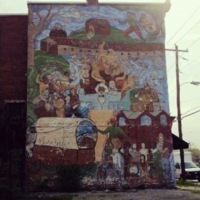
Neighborhood Center Mural Project
In July 1979, the city of Harrisburg saw a slice of its history on a wall at 610 Maclay Street. Painted under the direction of Toni Truesdale, the main theme of the mural was the history of the Underground Railroad in Harrisburg, along with a famous visit from Frederick Douglass and William Lloyd Garrison. In 1847, after both Garrison and Douglass returned from speaking tours in England, the two abolitionists decided to travel to Ohio to speak. Meeting in Philadelphia and speaking at other Pennsylvanian cities along the way, Douglass and Garrison reached Harrisburg on August 7, 1847. Garrison felt the city was “very much under the influence of Slavery. I do not anticipate a quiet meeting.” Garrison successfully finished his speech at the Dauphin County Court House to a full audience. But as Douglass reached the stage, audience members threw eggs. Douglass proceeded with his speech until he was interrupted by firecrackers. Someone also threw a stone at him. He observed that “the atrocious character of the proceedings is sufficiently palpable, and Harrisburg one day will be ashamed of it.”
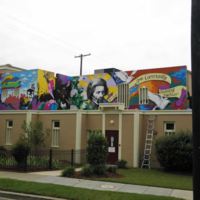
Bread for the City
In 2011, muralist Aniekan Udofia painted Bread for the City in Anacostia, D.C., close to the historic site of Frederick Douglass' house. The mural depicts Douglass in the younger, radical phase of his life, surrounded by doves and children, and the words “One People,” “One Community,” and “Building Together.” By 2016, the mural had been destroyed.
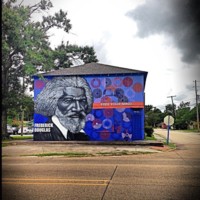
Free Your Mind
In 2013, Rahmann Statik painted two murals on the sides of a building in Beauregard Town, Baton Rouge. The murals cover the entirety of the building’s façade and reads, “Free Your Mind” alongside an image of Frederick Douglass, whilst the likeness of Harriet Tubman decorates the other side of the wall. Statik grew up on the southside of Chicago, surrounded by murals, and trained at the American Academy of Arts before working with Gallery 37 to teach mural creation to children. As of 2014, the mural no longer exists.
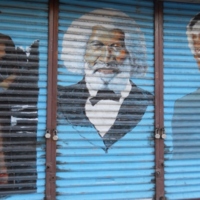
Tubman, Douglass, Mandela
This mural was created in 2008 by an unknown artist. Painted on a storefront on Ralph Avenue in Brooklyn, it depicted Harriet Tubman, Frederick Douglass and Nelson Mandela. As of 2014, it no longer existed.
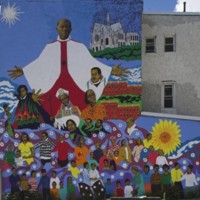
Father Paul Washington
Walter Edmonds memorialised Father Paul Washington of the Philadelphia Church of the Advocate, on the side of a building in the Strawberry Mansion district of Philadelphia in 1990. Father Washington was a prominent social activist in the area of Philadelphia.The creation of this mural is a good example of the call-and-response relationship generated by communities. After Walter Edmonds painted the mural Father Paul Washington, local residents were not satisfied with the likeness. As a result, Washington’s face was repainted by artist Stuart Yankell. Washington stands with arms outstretched surrounded by other local and famous heroes, including the antislavery leader Frederick Douglass.
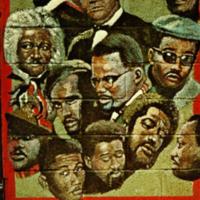
Nation of Islam
In 1990, this mural titled Nation of Islam at Charles Place in Brooklyn was created. The mural unites many radical figures of black history, including the antislavery leader Frederick Douglass, W.E.B. Du Bois, Elijah Muhammad, H. Rap Brown, Malcolm X, Marcus Garvey, Eldridge Cleaver and Bobby Seale. It has now been destroyed.
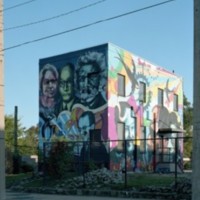
Seven Hills School Mural
Ed Trask, a Richmond-based muralist, created this mural in 2011 at the Seven Hills School in Richmond. It depicts the antislavery leader Frederick Douglass, as well as local figures Maggie Walker, Oliver W. Hill and Spottswood Robinson III. The other side of the building depicts Langston Hughes and W.E.B. Du Bois.
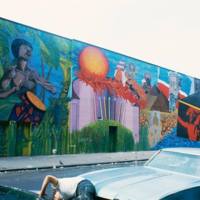
Afro Latin Coalition (Ghetto Ecstasy)
In 1973, Cityarts Workshop muralist James Jannuzzi painted a mural in New York City about Puerto Rican abolition, gang culture and black heritage. The mural includes a shirtless, muscular figure playing drums in a tropical landscape, Nubian symbols such as the ankh next to pyramids, and Ramón Emeterio Betances – an abolitionist and the father of the Puerto Rican independence movement. In the centre of the mural, Jannuzzi painted seven spears, acknowledging the presence of the neighbourhood’s seven gangs through the use of colour. By 1978, the mural had already started to deteriorate. Wanting to use the mural as a background in a film, a production company sought out Jannuzzi, asking him to retouch sections of the mural. Having hung up his paintbrush already, Jannuzzi directed the production company to Cityarts' Alfredo “Freddy” Hernandez who retouched the mural with a Dancing Madonna. By 1995 all that remained of Afro Latin Coalition was the Dancing Madonna in her red and white dress, and by 2000, the entire mural has disappeared.
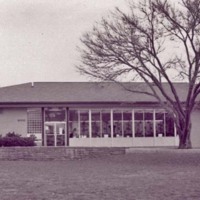
Odom Branch Library Mural
Woodrow Nash created a mural for the Odom Branch Library in the 1970s, depicting the antislavery leader Frederick Douglass alongside Martin Luther King Jr. and Malcolm X. In 1999, the library was remodelled and expanded to around 12,000 square feet. With the expansion came two new murals about black history. The original mural was edited – this time to incorporate the antslavery leader Sojourner Truth. By adding Truth to the mural, Nash was trying to reflect the contribution of women to the liberation struggle.
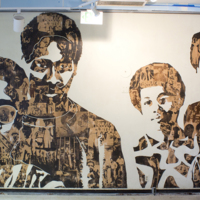
The Black Experience
In 1970, a group of seven black UCLA art students created a mural titled The Black Experience on the first floor of the Ackerman Student Union building. The mural, which measures 10 feet by 27 feet, was obscured for 20 years by a false wall erected in front of it during building renovations in 1992. Then in 2013, the mural was restored. “It was important in 1970, as it is today, to address issues of racial disparity on the UCLA campus,” one of the artists, Helen Singleton said. “Our mission in creating ‘The Black Experience’ mural was to expand and enhance that effort with a visual representation of the history and experience of African Americans in the United States.” The seven art students, Helen Singleton, Marian Brown, Neville Garrick, Andrea Hill, Jane Staulz, Joanne Stewart and Michael Taylor, are all depicted in the mural, alongside silk-screened graphics of the antislavery leaders Frederick Douglass and Harriet Tubman, alongside Martin Luther King Jr., Malcolm X, Bobby Seale, Huey P. Newton, Muhammad Ali, and Angela Davis. “We learned a lot about our history by exploring what images to use,” said Garrick, who was a freshman from Jamaica when he participated in the art project. In 2012, the effort to uncover the mural gained momentum after members of the Afrikan Student Union brought the mural to the attention of the Associated Students UCLA board of directors. At the unveiling in 2013, both Singleton and Garrick were guests of honour, along with activist Angela Davis.